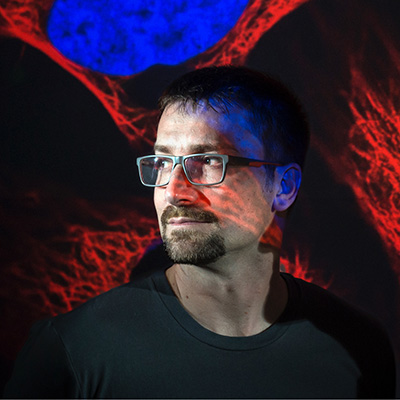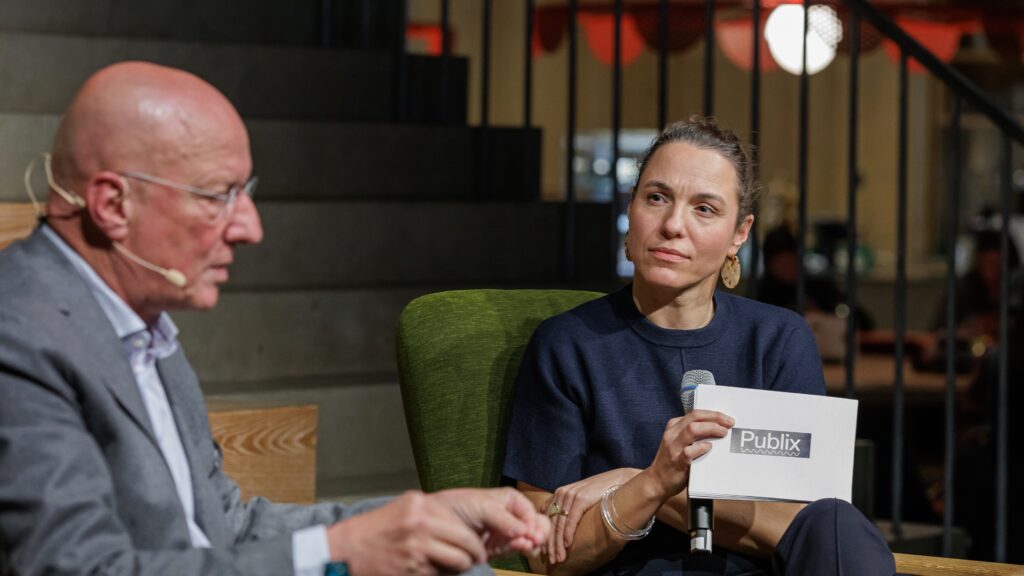A Tetris-like game enlists players of the looter-shooter Borderlands 3 to aid science. A researcher, a science communication professor and a video game expert talk about how to engage people with citizen science in video games.
Borderlands Science: Engaging gamers with research
Ms. Frick, you have played Borderlands Science, a mini science game within Borderlands 3, live on Twitch. What is the story of Borderlands 3 and how does its universe feel like?

Claudia Frick: Borderlands 3 is a first person looter-shooter that is part of an action role playing video game series. Its universe feels like a Space Western science fiction fantasy. Players take on the role of vault hunters. Their goal is to hunt for treasures and technologies from an ancient alien species and open up new vaults. Enemies, some harsh wildlife bandits or monsters, are trying to stop them. The players have to fight them off. It is a lot about looting and shooting.
Embedded in this Space Western experience is a science game. How does Borderlands Science work and how does it help actual research?
Jérôme Waldispühl: It is a Tetris kind-of casual game. I mean, what is better than Tetris? The idea is to solve a quick puzzle by moving blocks of four different colors. The puzzle is based on genetic sequences of microbes in the gut of tens of thousands of people collected by the American Gut Project, and by extension the Microsetta Initiative. Each block represents a different base of the genetic code. By solving the puzzle, players help us researchers to reorganize and compare the data on the microbiome. The results can highlight patterns in the data that show conserved DNA sequences during evolution and help us to better understand the genetic code of microbes. By aggregating the results of the players, we can find caveats in our algorithms that we use for pre-processing the data. Basically, it is a citizen science game.
Why is it worth to connect science and video games?

Attila Szantner: About six years ago, our startup came up with the idea of connecting major AAA games with scientific research. The data that citizen scientists accrue is very valuable for research. It is really amazing that us outsiders can chip into the scientific process. But citizen science in video games is not only a unique opportunity to do science, but also outreach and science communication. We do not too often get the opportunity to communicate with communities in a way in which they are actively participating in the process.
How do you engage players with science games?
Szantner: Research shows that people’s primary motivation to participate in citizen science is to actually help science. But the harsh reality is that we often ask players to do repetitive tasks that quickly get boring. That is why we had the idea of approaching the masters of engagement, game designers and game developers. They do not only have a lot of expertise in how to create engaging experiences; they could also give us access to their player base of millions, sometimes tens of millions of people, some of which have not reached by science yet.

Waldispühl: We developed a previous version of the citizen science game called “Phylo DNA puzzle” probably more than 10 years ago. The idea was to bring the aligning of DNA sequences into a casual game. The breakthrough was to work together with game designer and to revisit the game design completely. The previous version was arguably poorly designed and quite boring. Gearbox made the game developed by a computer scientist into something that the Borderlands gaming community enjoys playing.
Mr. Szantner, what are the challenges when implementing scientific content into commercial games?
Szantner: One of the reasons why we managed to pull off several successful collaborations with the gaming industry is that we try to find a matching research project to the game. Game designers do not want to break immersion. Their goal is to find content that they can somehow fit into the game. They try to match it with the game’s visual language and also its narrative.
Different research topics give you different artistic freedom. In case of the genetic sequences in Borderlands Science, we were really lucky. It is pure data which game designers could visualize as they wanted to. Whereas in our first project, Project Discovery in the game Eve Online, we asked players to classify fluorescence microscopy images for the Human Protein Atlas. Aesthetically, images from human cells was a hard constraint. But in the end, the images matched perfectly with the game.
Waldispühl: My background is in computer science. The true power of data in biology and genomics is that it is so diverse and versatile. We can potentially put this abstract data into many different contexts and different game designs and make it fit the host universe.
Szantner: Apart from connecting with the narrative and the aesthetic of the game, there is this part where we have to connect it with the game ecosystem, which usually manifests in some sort of rewards. In classical citizen science, some project leads find gamifying and rewarding users for their contribution counterproductive. Whereas in gaming, rewards are something to be expected. We say thank you to people for their contributions by rewarding them with some in-game advantage for playing Borderlands Science.

From a player’s perspective, how well does the science mini game fit into the Borderlands host universe, both from its game design and storyline?
Frick: I have to say it fits in perfectly. That is remarkable for several reasons: Borderlands has a very specific style. It has hand-drawn images with harsh black outlines. It looks almost cartoonish. You would definitely notice if the science game had different optics. In addition, the characters of the main game are built into Borderlands Science. You can also find the same very specific humor and the weird jokes of the main game. Moreover, gamers get rewarded for playing it. As I said, Borderlands is a looter-shooter. You kill enemies to earn better guns, to collect money and to level up. Completing puzzles in Borderlands Science earns you currency that can increase your possibility to get better loot. And that is something players want to have. I have friends and colleagues who are playing the science game for hours to get advantages in Borderlands 3.
How many people have played the game up until now and how many tasks did they already solve?
Szantner: Until now, we had almost 2.7 million people playing Borderlands Science.
Waldispühl: And we got 80 million puzzle solutions.
Szantner: I have recently checked the Zooniverse website, which is the biggest citizen science initiative with almost a 100 active research projects, to see how many classifications the community has solved and how many players there are. There were over 600 million classifications. With Borderlands Science, we are not there yet. But their platform is already running for 15 years.
Why are video games a great tool to engage the public with science?
Waldispühl: Video games are a great way to tell gamers what we are doing research on and how research works. We do not try to lecture the players, but engage them on different levels with science. Our goal is to improve transparency and give them a better sense about what we are doing. Science is no mystery. Video games are a way of empowering the players to contribute to science. They are also a perfect vehicle for science communication because they provide us an entry into a population that rarely interacts with science. I think, the best approach is not to convince them, but to try to engage them with science in general.
Mr. Frick, you are a professor of science communication and a gamer yourself. Do you agree with the statement that you learn about research when playing Borderlands Science?
Frick: This is an interesting question. You do not have to understand any of the science behind the game to be able to play it. There is a short video introduction in the beginning, which gives you the basics. But you can also skip it. I think, that is good, because it would be hurtful to the gaming experience to force players to watch it. Most gamers I have talked to were actually intrigued by the video and actively went to find out more about the research.
Waldispühl: You have hit the critical point. What we wanted is to stimulate curiosity without being intrusive. When we created “Phylo”, we aimed for a game that can be played without caring about the biology behind it. If you were interested in the research, we provided information on our web page. Our blog explains what we are doing and how science advances. Though that is a very slow pace.
What advantages do citizen science projects have by collaborating with commercial games?
Szantner: It is a typical win-win-win situation for science, the game companies and for the gaming communities. Beside the previously unseen level of activity of players, there are other very valuable advantages for science. The mentioned introductory video in Borderlands Science for example is narrated by Mayim Bialik. She is the star of Big Bang Theory, and also a researcher who has a PhD in neuroscience. She was perfect to represent the two sides of the Borderlands Science story. But creating such a high-profile trailer video is next to impossible for most citizen science projects to achieve. That is one example of what such collaborations can offer to science communication.
When we worked on an exoplanet research project with the University of Geneva for Project Discovery in Eve Online, we were really humbled that Michel Mayor accepted to participate in the project. He had discovered the first exoplanet and was awarded the Nobel prize in Physics in 2019 for his research. Mayor got an avatar in the game with which the players could interact. The fact that a scientist of his caliber came to a gaming convention in Icelands’ capital Reykjavik and gave a talk about his research to about four thousand players of Eve Online was a powerful message.







